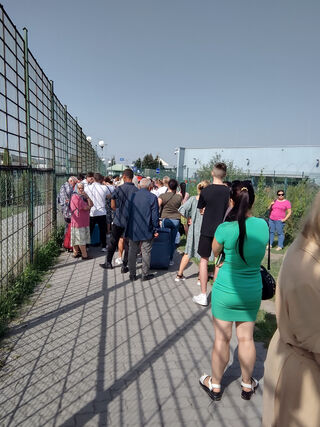Body Language
Human Trafficking on Ukraine’s Border
Traffickers specialize in spotting the traumatized and vulnerable.
Posted August 29, 2022 Reviewed by Hara Estroff Marano
Key points
- Traffickers are active on the Ukrainian border spotting and trapping potential victims.
- By using time pressure, traffickers create conditions for fleeing refugees to make bad decisions.
- A 24-hour shelter at the border would give refugees time to make better decisions.
As if Ukraine does not have enough going on, human traffickers are omnipresent on the borders between Ukraine and the West. The traffickers specialize in exploiting individuals traumatized by war.
A Trained Intelligence Professional Recognizes Traffickers
Last week, Stephen Komorek, CEO of API International Consulting Group, accompanied me to visit the border crossing at Medyka, in southeast Poland. An intelligence professional, now in the private sector, who specializes in combating human trafficking, Komorek is adept at detecting body language and other “tells” that may be invisible to people who don’t have his training.
The busy Medyka border with Ukraine is host to individuals who may look like taxi drivers, or maybe aid workers, who are almost certainly human traffickers. To Komorek’s trained eye, a hundred small tells of body language and sizing up potential victims reveal them as predators.
One thing he particularly notices: “Traffickers work as a team to select their victims. The first member of this team is the spotter. The spotter identifies and selects the potential victims. You can usually see spotters on their phones watching and calling in potential victims before the victims get where the second part of the team lurks, ready to take control of the victim.”
Traffickers Select Their Victims
Komorek knows that when a spotter is sizing up a prospective victim, he or she is checking out how exhausted and vulnerable the victim looks. Assuming the prospective victim is a woman, the trafficker will particularly be assessing the woman’s shoes, clothing, and posture.
Do the clothes look dirty and unpressed? Do her shoes look like she’s been walking for five days? Does her posture suggest that she’s so traumatized and exhausted that she can’t think straight?
“Traffickers use a variety of other techniques in order to identify potential victims,” Komorek adds. “The trafficker is also registering some basic questions: Does the female have children with her, and if so how old? Is she asking questions about where to go? How needy does she look?”

Tactics for Luring Victims
Komorek has often seen human traffickers approach exhausted women from the border and escort them and their children to a waiting bus, promising them food and shelter. They’ll also add time pressure, tellinga woman, “The bus is leaving in 10 minutes! Hurry! This is the last bus!”
Another technique, he points out, is to change maps posted around the aid areas. "Instead of showing the future victim the way to safety, a fake map directs women and children to the trafficker’s bus or van.”
Traffickers preferentially target women with children. Once a woman is under the trafficker’s control, says Komorek, he'll take her identification papers and then use the children as hostages in order to force women into sexual services.”
Organ Harvesting
Females are not the only targets of traffickers. “As gruesome and as horrible as it sounds,” Komorek reports, “sexual slavery is one of the better fates that may await a trafficking victim. Traffickers are now targeting refugees for organ harvesting.”
The tactics and techniques used to pick up displaced women and children for trafficking are also being used to capture individuals to sell their organs. "Kidneys are the top selling commodity," says Komorek. "People can buy them on the black market,"
What Can Be Done?
Komorek would like to see a government or volunteer shelter at border crossings where individuals could rest and recover for a day or two. “If this existed, they’d be able to make better decisions.” What the traffickers want is for the victims to be kept in time-pressured short-term thinking mode. "Traffickers use the same short-term thinking that interrogators use when we want to keep bad guys from thinking of future consequences while we work to get a confession,” points out Komorek.
“If displaced persons could be afforded a shelter at the border, something as simple as a good night’s rest and a conversation with a knowledgeable person could save their lives.” Komorek would love to see funding for a safe house and border center to counter human tafficking to interrupt the traffickers.
References
Salisbury University’s website for Ukrainian Relief


